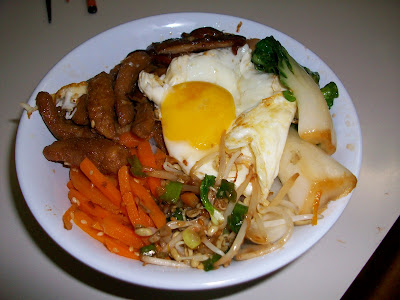I like an extra sweetness to my pizza so I always caramelize an onion to go along with the sauce under my cheese and toppings. Making your own sauce is also a good idea, as cans of tomato sauce are so much cheaper and easier to find kosher than other marinaras. I like to put 2 parts Basil, 1 part thyme, 1 part oregeno, along with some sugar and salt into a pot with a can of tomato sauce along with some paste depending on how much I am making. Test your own recipe and you can make exactly what you want in a matter of a few minutes for simple pasta or pizza heaven.
Jamie was a little tired of Asian lately, so I have been making some Pizzas and Pastas and soups for her, but I thought that it would be nice to get back into it with a mixture of both. Instead of peanut chicken I am switching it up and making Almond Chicken Pizza

Heres how you make the Almond Sauce for your veggie chicken!
1/2 cup Almond Butter
3/4 cup Boiling water
2 tbsp Soy Sauce or Terriyaki
Lime Juice
1 tsp Minced Ginger
Boil the water and add the soy sauce, Lime Juice and Ginger. After mixing together add almond butter and constantly stir until you have a nice thick paste.
Now making the pizza is fairly easy; find a dough recipe you like online or buy some dough in the super market. If you want a more artisan dough - use Peter Reinhardt's recipe here, he is the bread master, and his cookbook, The Bread Baker's Apprentice is a must buy for those who are more interested in bread baking.
Make two batches of the sauce so you can mix one with your back of Morningstar chicken strips and have some for dipping. At the end of making the bag of strips, add one of the sauce batches and sautee until the strips begin to burn a little.
Carmelize the onions quickly by sauteeing one onion in 2 tbsp butter. After 2 minutes add a tsp of Salt and a Tbsp of Sugar. Mix ingredients and let sit for five minutes until soft and nice.
Stretch the dough, add the sauce, onions and cover with your cheese. After this add the chicken and any other toppings you might like.
Check it.

















